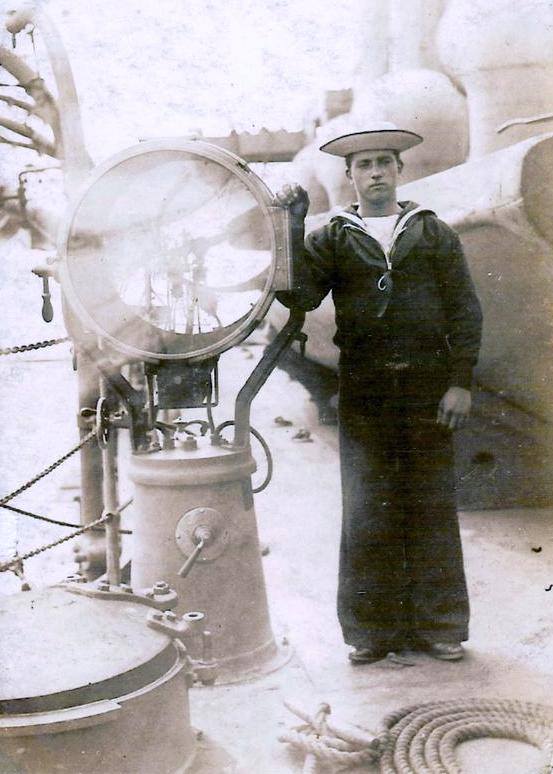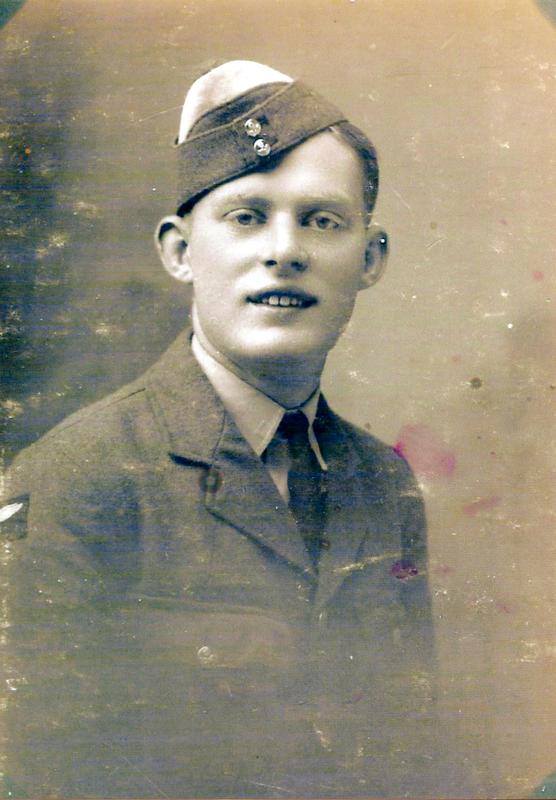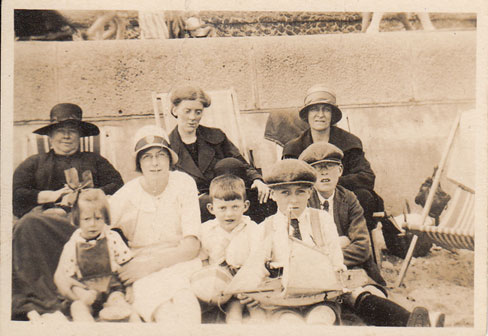I’ve mentioned Grandma’s photo album before, when it turned out that the unnamed WW1 soldier posing in a Brighton studio was in fact her Uncle Bill. The photo above, of Grandma on a family seaside outing, interested me as it showed two of her cousins, and aunts of hers who I knew nothing about. She had written on the back identifying the people in the photo as:
- back row: left to right – Aunt Rose, Aunt Elsie, Mum
- front row: left to right – Eileen, Amy (my grandma), Jack, Les, Ron
I’m not 100% sure who Aunt Rose was, but Aunt Elsie is grandma’s paternal aunt. She was born in Fingringhoe in 1895, after the Kemble family had moved from Acton in Suffolk in about 1890. Her brother, William James Kemble, is my great-grandfather. By 1901, most of the Kembles had moved across the River Colne to Wivenhoe (grandma mentioned she had an uncle from Fingringhoe who drove his milk-cart through the Colne at low-tide through the mud!).
In 1920, Elsie married Edwin Joseph Green. The Greens are quite a ‘famous’ Wivenhoe family, as at one point Edwin ran the fish and chip shop. Here we see Edwin, with his brother Alex, in the doorway of John Fale’s fish shop on East Street:

The Green family weren’t strangers to tragedy. Their parents, James William Green and Emma Durrell, had seven children, six of whom were boys. In the summer of 1903, their only daughter, Ida Emma Green, drowned in the River Colne. She was only 3, and had been playing George Durrell (presumably a cousin). When George lost sight of her, he called Ernest – another Green brother – to help find her, and it was Ernest who discovered his drowned sister “wedged in between two balks of timber, in about a foot of water.”[1]Essex Newsman, 22nd August 1903
And then in 1916, aged only 18, Jack Durrell Green died of dysentery in the Royal Naval Hospital in Malta. He was the youngest telegraphist in the Royal Navy, and his father and three of his brothers were also serving on the high seas.

 He wasn’t the only son to die in WW1. William John Green had moved to Grimsby and was a trawlerman. He died at sea in 1917 – his trawler went down and all hands were lost. He left behind him a widow, Lillie, and two daughters, Ida (presumably named after the aunt she never met) and Lillie. Both brothers appear on the WW1 side of Wivenhoe’s war memorial in the churchyard of St. Mary’s.
He wasn’t the only son to die in WW1. William John Green had moved to Grimsby and was a trawlerman. He died at sea in 1917 – his trawler went down and all hands were lost. He left behind him a widow, Lillie, and two daughters, Ida (presumably named after the aunt she never met) and Lillie. Both brothers appear on the WW1 side of Wivenhoe’s war memorial in the churchyard of St. Mary’s.
I wonder if, when Elsie and Edwin’s son was born in first child was born the year after their wedding, they named him Jack in honour of Edwin’s brother? Jack Edwin was followed by Eileen Elsie in 1923, and Marjorie Amy in 1926. I think we might assume the beach photo dates from just before Marjorie’s birth – she was born in the November, and Elsie’s uncomfortable pose might suggest that of a pregnant woman fidgetting in a deckchair. She has her hat on her lap, which might indicate she was hiding her baby-bump from the camera. Sadly, Elsie’s health failed and she died in 1928, but Edwin married Lily Payne in 1929, and life continued for the Green family. In 1935, there was near-disaster a fire in Edwin’s fish ‘n’ chip shop caused £200-worth of damage – a not-inconsiderable small sum back then.[2]Chelmsford Chronicle, 5th July 1935 The Greens lived nextdoor to the shop, and it was only because some passersby in the early morning noticed the flames that the fire was easily extinguished.
In 1942, Jack Edwin Green, aged 21, married Mary Round. He was a Flight Sergeant in the RAF, flying Spitfires in the RAF Volunteer Squadron, flying with Czechoslovakians. The Czechoslovak Minister of Defence allowed Jack to wear the badge of honour of the Czechoslovak Air Force. A year after his marriage, he was flying out of the Wormshill base in Kent.

On 12th September 1943, something terrible happened. The base’s logbook, held at The National Archives, says:
Mist and low cloud. No operations. Flight Sergeant Green (British) was killed in non-operational flight in Wormshill, Kent. The accident was believed to have been caused through aircraft striking high ground in bad visibility.
He crashed at Yew Tree Farm; his Spitfire broke up on impact and he was killed instantly.
Another Green boy had died in war. Mary was pregnant at the time, and father and son never met. He was buried in Wivenhoe’s new cemetery, his resting place marked by a Commonwealth War Graves Commission headstone: “Swift and sudden was his call.” When Jack’s father died, he was laid to rest beside his son.
His name appears on the same memorial in St. Mary’s churchyard as his two uncles:
As part of the commemorations for WW2, Jack Green has been remembered by the people of Wivenhoe. In the little chapel in the New Cemetery, a ‘scramble bell’ has been placed, the kind that would’ve summoned Jack to his plane, and up into the limitless reaches of the sky.
Thank you to John Stewart for extra photos and additional info, and Robin for checking the Wormhill logbook at TNA.




